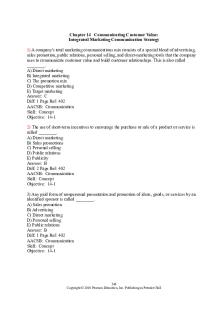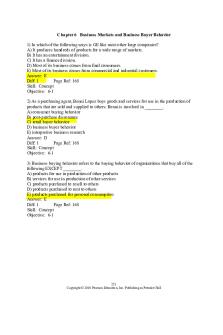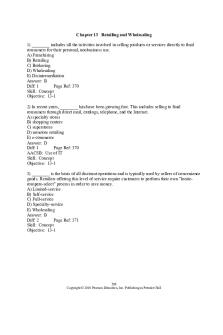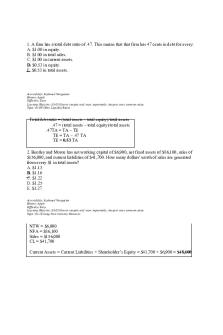Kotler Chapter 14 MCQ - Multiple choice questions with answers PDF

| Title | Kotler Chapter 14 MCQ - Multiple choice questions with answers |
|---|---|
| Course | Principles of Marketing |
| Institution | The University of the West Indies Mona |
| Pages | 44 |
| File Size | 285.8 KB |
| File Type | |
| Total Downloads | 416 |
| Total Views | 908 |
Summary
Chapter 14 Communicating Customer Value: Integrated Marketing Communication Strategy A company's total marketing communications mix consists of a special blend of advertising, sales promotion, public relations, personal selling, and direct-marketing tools that the company uses to communicate custome...
Description
Chapter 14 Communicating Customer Value: Integrated Marketing Communication Strategy 1) A company's total marketing communications mix consists of a special blend of advertising, sales promotion, public relations, personal selling, and direct-marketing tools that the company uses to communicate customer value and build customer relationships. This is also called ________. A) Direct marketing B) Integrated marketing C) The promotion mix D) Competitive marketing E) Target marketing Answer: C Diff: 1 Page Ref: 402 AACSB: Communication Skill: Concept Objective: 14-1 2) The use of short-term incentives to encourage the purchase or sale of a product or service is called ________. A) Direct marketing B) Sales promotions C) Personal selling D) Public relations E) Publicity Answer: B Diff: 2 Page Ref: 402 AACSB: Communication Skill: Concept Objective: 14-1 3) Any paid form of nonpersonal presentation and promotion of ideas, goods, or services by an identified sponsor is called ________. A) Sales promotion B) Advertising C) Direct marketing D) Personal selling E) Public relations Answer: B Diff: 1 Page Ref: 402 AACSB: Communication Skill: Concept Objective: 14-1
548 Copyright © 2010 Pearson Education, Inc. Publishing as Prentice Hall
4) Which of the five major promotion tools includes building up a positive corporate image and handling unfavorable stories and events? A) Sales promotion B) Personal selling C) Direct marketing D) Public relations E) Advertising Answer: D Diff: 2 Page Ref: 402 AACSB: Communication Skill: Concept Objective: 14-1 5) Which of the following is NOT a major category in a company's promotion mix? A) Sales promotion B) Strategic positioning C) Direct marketing D) Public relations E) Advertising Answer: B Diff: 2 Page Ref: 402 AACSB: Communication Skill: Concept Objective: 14-1 6) Which major promotion category makes use of catalogs, telephone marketing, kiosks, and the Internet? A) Sales promotion B) Direct marketing C) Publicity D) Public relations E) Advertising Answer: B Diff: 2 Page Ref: 402 AACSB: Communication Skill: Concept Objective: 14-1
549 Copyright © 2010 Pearson Education, Inc. Publishing as Prentice Hall
7) Which major promotion category makes use of displays, discounts, coupons, and demonstrations? A) sales promotion B) direct marketing C) publicity D) public relations E) advertising Answer: A Diff: 2 Page Ref: 403 AACSB: Communication Skill: Concept Objective: 14-1 8) The promotion mix is the company's primary communication activity; the marketing mix must be coordinated for the greatest communication impact. What is NOT included in the entire marketing mix? A) product B) competitor C) price D) place E) promotion Answer: B Diff: 2 Page Ref: 403 Skill: Concept Objective: 14-1 9) Mass-media advertising routinely involves a company investing millions or even billions of dollars to reach tens of ________ of customers with a single ad. A) billions B) thousands C) millions D) hundreds E) tens Answer: C Diff: 1 Page Ref: 403 AACSB: Communication Skill: Concept Objective: 14-2
550 Copyright © 2010 Pearson Education, Inc. Publishing as Prentice Hall
10) Today's consumers do not need to rely on marketer-supplied information about products and services because they can use ________ to seek out a wealth of information. A) public relations B) direct marketing C) the Internet and other technologies D) mass market media E) informative advertising Answer: C Diff: 1 Page Ref: 403 AACSB: Use of IT Skill: Concept Objective: 14-2 11) Which of the following is NOT a factor in the changes occurring in today's marketing communications? A) Mass markets have fragmented, and marketers are shifting away from mass marketing. B) Improvements in communication technologies are changing how companies and customers communicate with each other. C) Companies routinely invest millions of dollars in the mass media. D) Mass media no longer capture the majority of promotional budgets. E) Today's consumers are better informed about products and services. Answer: D Diff: 3 Page Ref: 403 AACSB: Communication Skill: Concept Objective: 14-2 12) Moving away from ________, marketers have been shifting toward highly focused marketing, spawning a new generation of more specialized and highly targeted communications efforts. A) mass marketing B) advertising C) direct marketing D) pull strategies E) push strategies Answer: A Diff: 2 Page Ref: 403 AACSB: Communication Skill: Concept Objective: 14-2
551 Copyright © 2010 Pearson Education, Inc. Publishing as Prentice Hall
13) Which of the following is NOT an example of a specialized and highly-targeted media that an advertiser might use to reach smaller customer segments? A) cable television channels B) e-mail C) podcasts D) network television E) online social networks Answer: D Diff: 2 Page Ref: 404 AACSB: Use of IT Skill: Concept Objective: 14-2 14) Companies are doing less ________ and more ________ as a result of an explosion of more focused media that better match today's targeting strategies. A) marketing; media B) media; sales C) narrowcasting; broadcasting D) broadcasting; narrowcasting E) advertising; word-of-mouth Answer: D Diff: 2 Page Ref: 404 AACSB: Communication Skill: Concept Objective: 14-2 15) In the "chaos scenario" predicted by some advertising industry experts, the old mass-media communications model will be abandoned in favor of ________. A) public relations B) direct marketing C) push and pull strategies D) the possibilities of new digital technologies E) buzz marketing Answer: D Diff: 2 Page Ref: 404 AACSB: Use of IT Skill: Concept Objective: 14-2
552 Copyright © 2010 Pearson Education, Inc. Publishing as Prentice Hall
16) All of the following are reasons that marketers are losing confidence in television advertising EXCEPT which one? A) TV ad spending is rising at a slower rate than online ad spending. B) TV and other mass media still capture the lion share of promotional budgets. C) Many viewers are using video on demand and TiVo-like systems. D) Younger consumers are using different media. E) TV audience size is on the decline. Answer: B Diff: 3 Page Ref: 404 AACSB: Communication Skill: Concept Objective: 14-2 17) Companies often fail to integrate their various communications to consumers because ________. A) historically, consumers have been able to distinguish between message sources B) advertising departments are reluctant to work with public relations professionals C) communications often come from different parts of the company D) personal selling and sales promotion are in direct conflict E) they have failed to understand the concept of brand contact Answer: C Diff: 2 Page Ref: 405 AACSB: Communication Skill: Concept Objective: 14-2 18) All too often companies today have failed to ________ their various communications channels, resulting in a hodgepodge of communications to consumers. A) promote B) rechannel C) integrate D) open E) verify Answer: C Diff: 1 Page Ref: 405 AACSB: Communication Skill: Concept Objective: 14-2
553 Copyright © 2010 Pearson Education, Inc. Publishing as Prentice Hall
19) Consumers today receive commercial messages from a broad range of sources. However, consumers ________ the way marketers do. A) don't distinguish between message sources B) are able to differentiate among messages sources C) don't care about buzz marketing D) are not able to block out messages E) block them all out Answer: A Diff: 2 Page Ref: 405 AACSB: Communication Skill: Concept Objective: 14-2 20) More companies are adopting the concept of ________, which carefully integrates and coordinates the company's many communication channels to deliver a clear, consistent, and compelling message about the organization and its brands. A) Integrated marketing communications B) Integrated personal selling C) Integrated competitive methods D) Non-personal communication channels E) Buzz marketing Answer: A Diff: 3 Page Ref: 405 AACSB: Communication Skill: Concept Objective: 14-2 21) Advertising, sales promotion, personal selling, public relations, and direct marketing are all ________. A) communications channels that should be integrated under the concept of integrated marketing communications B) communications channels focused more on narrowcasting than broadcasting C) promotional tools used for push strategies but not pull strategies D) promotional tools used for pull strategies but not push strategies E) promotional tools adapted for use in mass marketing Answer: A Diff: 2 Page Ref: 405 AACSB: Communication Skill: Concept Objective: 14-2
554 Copyright © 2010 Pearson Education, Inc. Publishing as Prentice Hall
22) Integrated marketing communications require a company's mass-market advertisements, Web site, e-mail, and personal selling communications to all have ________. A) Equal portions of the advertising budget B) Independent communications directors C) Separate marketing objectives D) The same target audience E) The same message, look, and feel Answer: E Diff: 2 Page Ref: 406 AACSB: Communication Skill: Concept Objective: 14-2 23) To produce better communications consistency, a unified company image, and greater sales impact, some companies employ a(n) ________. A) advertising agency B) marketing communications director C) public relations specialist D) personal sales force E) media planner Answer: B Diff: 2 Page Ref: 407 AACSB: Communication Skill: Concept Objective: 14-2 24) Integrated marketing communications produces better communications ________ and greater ________ impact. A) consistency; sales B) sales; consistency C) marketing; sales D) variety; production E) branding; quality Answer: A Diff: 2 Page Ref: 407 AACSB: Communication Skill: Concept Objective: 14-2
555 Copyright © 2010 Pearson Education, Inc. Publishing as Prentice Hall
25) Today, marketers are moving toward viewing communications as managing the ________ over time. A) advertising agency B) nonpersonal communication channels C) word-of-mouth influence D) customer relationship E) product life cycle Answer: D Diff: 2 Page Ref: 407 AACSB: Communication Skill: Concept Objective: 14-3 26) Integrated marketing communications involves identifying the target audience and shaping a well-coordinated ________ to elicit the desired audience response. A) pull strategy B) push strategy C) promotional program D) opinion leader E) target market Answer: C Diff: 2 Page Ref: 407 AACSB: Communication Skill: Concept Objective: 14-3 27) Using integrated marketing communications, the communications process should start with ________. A) advertising strategy B) the competitive-parity method C) public relations D) an audit of all the potential customer touch points E) publicity Answer: D Diff: 3 Page Ref: 408 AACSB: Communication Skill: Concept Objective: 14-3
556 Copyright © 2010 Pearson Education, Inc. Publishing as Prentice Hall
28) Which of the following is NOT one of the four major communication functions? A) feedback B) encoding C) noise D) response E) decoding Answer: C Diff: 2 Page Ref: 408 AACSB: Communication Skill: Concept Objective: 14-3 29) The communication channel a company uses to move its advertising messages from sender to receiver is called the ________. A) message B) media C) encoder D) communicator E) feedback loop Answer: B Diff: 2 Page Ref: 408 AACSB: Communication Skill: Concept Objective: 14-3 30) The receiver assigns meaning to the symbols encoded by a company in its advertisements through a process known as ________. A) disencoding B) feedback C) acknowledgement D) decoding E) response Answer: D Diff: 2 Page Ref: 408 AACSB: Communication Skill: Concept Objective: 14-3
557 Copyright © 2010 Pearson Education, Inc. Publishing as Prentice Hall
31) In the communication process, the reaction of the receiver after being exposed to a message is called the ________. A) response B) answer C) noise D) feedback E) decoding Answer: A Diff: 1 Page Ref: 409 AACSB: Communication Skill: Concept Objective: 14-3 32) When a customer lets a producer know something about its products or advertising, the customer is providing ________. A) decoding B) noise C) feedback D) encoding E) reverse marketing Answer: C Diff: 2 Page Ref: 409 AACSB: Communication Skill: Concept Objective: 14-3 33) A consumer is reading a magazine with an advertisement, but is distracted from reading the advertisement or its key points. This unplanned static or distortion during the communication process is called ________. A) noise B) distraction C) feedback D) response E) decoding Answer: A Diff: 2 Page Ref: 409 AACSB: Communication Skill: Concept Objective: 14-3
558 Copyright © 2010 Pearson Education, Inc. Publishing as Prentice Hall
34) In the communication process, the more the sender's field of experience ________ that of the receiver, the more ________ the message is likely to be. A) varies from; distinguishable B) overlaps with; effective C) connects with; ineffective D) coincides with; creative E) departs from; direct Answer: B Diff: 3 Page Ref: 409 AACSB: Communication Skill: Concept Objective: 14-3 35) To communicate effectively, a marketing communicator must ________ the consumer's field of experience. A) compete with B) share C) understand D) create E) reference Answer: C Diff: 2 Page Ref: 409 AACSB: Communication Skill: Concept Objective: 14-3 36) Marketing communicators must be good at ________ messages that take into account how the target audience ________ them. A) delivering; encodes B) sending; encodes C) encoding; decodes D) retrieving; perceives E) decoding; receives Answer: C Diff: 3 Page Ref: 409 AACSB: Communication Skill: Concept Objective: 14-3
559 Copyright © 2010 Pearson Education, Inc. Publishing as Prentice Hall
37) Marketing communicators must do all of the following EXCEPT ________. A) identify the target audience B) deliver products to the customer C) determine the communication objectives D) collect feedback E) choose the media through which to send a message Answer: B Diff: 2 Page Ref: 409 AACSB: Communication Skill: Concept Objective: 14-3 38) The six ________ stages that consumers normally pass through on their way to making a purchase include awareness, knowledge, liking, preference, conviction, and purchase. A) personal readiness B) buyer-readiness C) objective readiness D) purchase direct readiness E) supplier readiness Answer: B Diff: 2 Page Ref: 409 Skill: Concept Objective: 14-3 39) The six buyer-readiness stages include all of the following EXCEPT ________. A) awareness B) knowledge C) power D) liking E) hesitation Answer: E Diff: 2 Page Ref: 409 Skill: Concept Objective: 14-3 40) In the model of buyer-readiness stages, the first stage is ________. A) preference B) knowledge C) liking D) awareness E) insistence Answer: D Diff: 1 Page Ref: 409 Skill: Concept Objective: 14-3
560 Copyright © 2010 Pearson Education, Inc. Publishing as Prentice Hall
41) All of the following are strategies a marketer would use to lead consumers into making the final step toward a purchase EXCEPT which one? A) offer special promotional prices B) offer add-on features C) offer premiums D) use extensive "teaser" advertising E) C or D Answer: D Diff: 3 Page Ref: 410 AACSB: Communication Skill: Concept Objective: 14-3 42) A message showing a product's quality, economy, value, or performance is called a(n) ________ appeal. A) structural B) rational C) emotional D) moral E) standard Answer: B Diff: 2 Page Ref: 411 AACSB: Communication Skill: Concept Objective: 14-3 43) Marketers using humor in their messages claim that they attract more attention and create more loyalty and belief in the brand. This type of message is called a(n) ________ appeal. A) rational B) structural C) emotional D) moral E) standard Answer: C Diff: 2 Page Ref: 411 AACSB: Communication Skill: Concept Objective: 14-3
561 Copyright © 2010 Pearson Education, Inc. Publishing as Prentice Hall
44) Though a popular appeal, when used poorly ________ can detract from comprehension, quickly wear out its welcome, overshadow the product, or even irritate consumers. A) humor B) nonpersonal communication C) direct marketing D) integrated marketing E) noise Answer: A Diff: 3 Page Ref: 411 AACSB: Communication Skill: Concept Objective: 14-3 45) Moral appeals are directed to the audience's sense of what is "right" and ________. A) proper B) affordable C) traditional D) positive E) emotional Answer: A Diff: 2 Page Ref: 411 AACSB: Communication Skill: Concept Objective: 14-3 46) The communicator must decide how to handle message structure issues. One issue is whether to ________ or not. A) draw a conclusion B) make a moral appeal C) use the pull strategy D) use the push strategy E) avoid competitors Answer: A Diff: 3 Page Ref: 411 AACSB: Communication Skill: Concept Objective: 14-3
562 Copyright © 2010 Pearson Education, Inc. Publishing as Prentice Hall
47) A(n) ________ argument is only likely to be effective when the audience is highly educated or likely to hear opposing claims, or when the communicator has a negative association to overcome. A) two-sided B) one-sided C) moral D) emotional E) scientific Answer: A Diff: 3 Page Ref: 412 AACSB: Communication Skill: Concept Objective: 14-3 48) In designing the message structure, marketers must decide whether to present the ________ arguments first or last in a message. A) emotional B) structural C) moral D) strongest E) scientific Answer: D Diff: 2 Page Ref: 411 AACSB: Communication Skill: Concept Objective: 14-3 49) The two broad types of ________ channels are personal and nonpersonal. A) marketing B) competitive C) communication D) buyer E) seller Answer: C Diff: 1 Page Ref: 412 AACSB: Communication Skill: Concept Objective: 14-3
563 Copyright © 2010 Pearson Education, Inc. Publishing as Prentice Hall
50) Communication through the mail is categorized as a(n) ________ communication channel. A) nonpersonal B) word-of-mouth C) personal D) objective E) inefficient Answer: C Diff: 2 Page Ref: 412 AACSB: Communication Skill: Concept Objective: 14-3 51) Creating word-of-mouth campaigns by cultivating opinion leaders and getting them to spread information about a product or service to others in their communities is known as ________. A) sales promotion B) indirect marketing C) buzz marketing D) stealth marketing E) public relations Answer: C Diff: 1 Page Ref: 413 AACSB: Communication Skill: Concept Objective: 14-3 52) Nonpersonal communication channels include major media, ________, and events. A) sales calls B) buzz marketing C) atmospheres D) word of mouth E) e-mail Answer: C Diff: 2 Page Ref: 413 AACSB: Communication Skill: Concept Objective: 14-3
564 Copyright © 2010 Pearson Education, Inc. Publishing as Prentice Hall
53) Vast numbers of consumers are aware of your product. It is now your goal to enhance preference for your product. You plan to use nonpersonal communications through print media. This will include all of the following EXCEPT ________. A) newspapers B) magazines C) Internet "chats" D) direct mail E) catalogs Answer: C Diff: 1 Page Ref: 413 AACSB: Communication Skill: Concept Objective: 14-3 54) To ________, a marketer can ask target audience members whether they remember the message, how many times they saw it, and what points they remember. A) select a message source B) collect feedback C) select a message channel D) plan a media purchase E) design a marketing appeal Answer: B Diff: 2 Page Ref: 414 AACSB: Communication Skill: Concept Objective: 14-3 55) ________ from marketing communications may suggest changes in the promotion program or in the product offer itself. A) Encoding B) Decoding C) Feedback D) Noise E) Shelter Answer: C Diff: 2 Page Ref: 414 AACSB: Communication Skill: Concept Objective: 14-3
565 Copyright © 2010 Pearson Education, Inc. Publishing as Prentice Hall
56) Companies use all of the following methods to set their advertising budget EXCEPT the ________. A) objective-and-task method B) integrated method C) competitive-parity method D) percentage-of-sales method E) affordable method Answer: B ...
Similar Free PDFs
Popular Institutions
- Tinajero National High School - Annex
- Politeknik Caltex Riau
- Yokohama City University
- SGT University
- University of Al-Qadisiyah
- Divine Word College of Vigan
- Techniek College Rotterdam
- Universidade de Santiago
- Universiti Teknologi MARA Cawangan Johor Kampus Pasir Gudang
- Poltekkes Kemenkes Yogyakarta
- Baguio City National High School
- Colegio san marcos
- preparatoria uno
- Centro de Bachillerato Tecnológico Industrial y de Servicios No. 107
- Dalian Maritime University
- Quang Trung Secondary School
- Colegio Tecnológico en Informática
- Corporación Regional de Educación Superior
- Grupo CEDVA
- Dar Al Uloom University
- Centro de Estudios Preuniversitarios de la Universidad Nacional de Ingeniería
- 上智大学
- Aakash International School, Nuna Majara
- San Felipe Neri Catholic School
- Kang Chiao International School - New Taipei City
- Misamis Occidental National High School
- Institución Educativa Escuela Normal Juan Ladrilleros
- Kolehiyo ng Pantukan
- Batanes State College
- Instituto Continental
- Sekolah Menengah Kejuruan Kesehatan Kaltara (Tarakan)
- Colegio de La Inmaculada Concepcion - Cebu















